Anti-theft strips are a common security measure used by retailers to deter shoplifting. These strips, often found on merchandise like electronics and clothing, contain a circuit that triggers an alarm if not deactivated properly at checkout. While they provide valuable protection for businesses, they can be a nuisance if they activate after you’ve left the store, especially if you’re unsure how to deactivate them.
This guide will walk you through the different types of anti-theft strips, how to identify if one is still active, and most importantly, how to deactivate them safely and effectively.
Understanding Anti-theft Strips and Their Purpose
Before we delve into deactivation, let’s understand how these security devices work. Most retail anti-theft strips use one of two main technologies:
- Radio-Frequency (RF) tags: These tags consist of a microchip and an antenna that emit a radio frequency signal. When the tag passes through the store’s security gates, the signal is detected, triggering an alarm if it hasn’t been deactivated.
- Acousto-Magnetic (AM) tags: These tags work on a different principle, using a strip of amorphous metal that resonates at a specific frequency. When exposed to an electromagnetic field at the store’s exit, the tag vibrates and generates a signal that sets off the alarm.
Knowing the difference between RF and AM tags isn’t crucial for deactivation, as the deactivation process is generally handled by the cashier at checkout. However, it’s helpful to understand the technology behind these security measures.
 RF and AM Anti-theft Tags
RF and AM Anti-theft Tags
Identifying an Active Anti-theft Strip
You’ll typically find anti-theft strips attached to merchandise or packaging. They come in various forms, such as:
- Adhesive stickers: These are commonly found on smaller items and contain a thin, flexible circuit.
- Hard tags: These are more durable and are often attached to clothing or accessories with a pin or cable.
- Deactivatable ink tags: Some retailers use security tags with ink capsules that rupture if tampered with.
If you’re unsure whether an anti-theft strip is still active, check for the following:
- Visual inspection: Look for any visible wires, circuits, or metallic strips on the tag.
- Feel for thickness: Active tags, especially RF tags, might have a slightly thicker area where the microchip and antenna are located.
If you’ve brought an item home and suspect an anti-theft strip is still active, it’s best to address it to avoid potential embarrassment or issues if the alarm triggers elsewhere.
How to Deactivate Anti-theft Strips
It’s important to note that attempting to deactivate anti-theft strips yourself is generally not recommended. Tampering with them can damage the merchandise and might be illegal in some areas.
The safest and most reliable way to deactivate anti-theft strips is to return to the store where you purchased the item and request assistance from a staff member. They have the proper tools and training to safely deactivate the strips without causing any harm.
Retailers use specialized equipment to deactivate anti-theft strips:
- RF deactivators: These devices emit a strong electromagnetic pulse that disrupts the circuit in RF tags, rendering them inactive.
- AM deactivators: These use a focused magnetic field to demagnetize the metal strip in AM tags, effectively silencing them.
 Retail Staff Deactivating Tag
Retail Staff Deactivating Tag
Attempting to deactivate these strips using DIY methods found online is risky and can lead to unintended consequences.
FAQs about Anti-theft Strips
Here are some commonly asked questions about anti-theft strips:
Q: Can anti-theft strips damage my car’s electronics?
A: While it’s rare, active RF tags can potentially interfere with sensitive electronics in close proximity. However, the chances of this happening are slim, and the interference is usually temporary.
Q: Can I remove an anti-theft strip myself?
A: It’s not recommended. Attempting to remove or deactivate them yourself can damage the item and might be illegal.
Q: What should I do if an alarm triggers even though I paid for the item?
A: Remain calm and cooperate with the store staff. Provide your receipt as proof of purchase, and they’ll be able to verify the deactivation.


